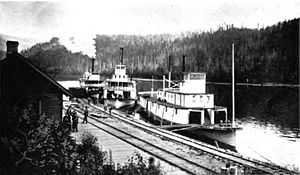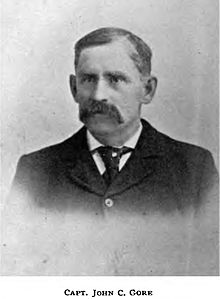- Columbia (Arrow Lakes sternwheeler)
-

Sternwheelers Lytton (in distance), Columbia (center vessel with high pilot house), and Kootenai (on right) at Robson, BC, sometime between 1890 and 1894Career Name: Columbia[1][2] Owner: Columbia and Kootenay Steam Navigation Company Route: Arrow Lakes Builder: Joseph Paquet or Alexander Watson[3] Cost: $75,000 Maiden voyage: August 20, 1891 In service: 1891 Out of service: 1894 Identification: CAN 126880[4] Fate: destroyed by fire General characteristics Type: inland shallow-draft boat passenger/freighter Tonnage: 534 gross; 378 net Length: 152.6 ft (47 m) Beam: 28 ft (9 m) Depth: 6.3 ft (2 m) depth of hold Installed power: steam engines manufactured by Harlan & Hollingsworth of Wilmington, Delaware, twin single-cylinder, horizontally mounted, 17" bore by 72" stroke, 19 hp (14 kW) nominal[1] Propulsion: sternwheel Columbia was a sternwheel steamboat that ran on the Arrow Lakes in British Columbia from 1890 to 1894. Columbia should be distinguished from the many other vessels with the same or similar names, including in particular the propeller-driven steamboat edit] The Arrow Lakes route
Columbia was the fourth large sternwheeler to run on the 130-mile (210 km) long Arrow Lakes (and adjacent stretches of the Columbia River). Before the construction of the Keenleyside Dam in the 1960s, there were two Arrow Lakes, called the upper and lower, which were separated by a stretch of shallow water known as the Narrows. The lakes are part of the Columbia River, which flows into the upper Arrow Lake at Arrowhead, British Columbia, and begins again at the southern end of the lower lake near the towns of Robson and Castlegar. Steamers running on Arrow Lakes typically started from the railheads. In the early 1890s the northern railhead was Revelstoke about 25 miles (40 km) up the Columbia River from Arrowhead, where the transcontinental line of the Canadian Pacific Railway crossed the Columbia. In the south, the Great Northern Railway had reached Little Dalles, Washington by the 1890s. Rail construction was ongoing however. C.P.R. was building an extension south from Revelstoke along the east side of the Columbia River, which would eventually reach Arrowhead. By 1894 the extension had only gone as far as the town of Wigwam, about half way between Revelstoke and Arrowhead, which became the northernmost point on the route for Columbia.[2][5]
Design and construction
Columbia was built in the United States at Little Dalles (now known as Northport for the Columbia and Kootenay Steam Navigation Company. The vessel's hull had been built at Portland, Oregon then disassembled into sections and shipped by rail to Northport to be reassembled and launched. On the Arrow Lakes Columbia was the fifth sternwheeler and the largest ever built up to that time. [5][2]
Operations on Arrow Lakes
Under Captain John C. Gore she made her first trip north from Little Dalles to Robson, British Columbia, on August 20, 1891, leaving at 1:00 p.m. in the afternoon and arriving at Robson between 7:00 and 8:00 p.m. She left for Revelstoke on August 22, 1891. The addition of Columbia to the C.K.S.N.'s fleet allowed the company to maintain, with the similarly designed sidewheeler Lytton, twice weekly trips from Revelstoke to Little Dalles.[2]
On one trip north, Columbia's hogchains (the steel cables that keep the lightly built hull of an inland steamboat in shape) parted, causing the ship to become hogged, that is the hull sagged at the bow and the stern. This would have made the vessel unsafe to use until the hog chains could be repaired and the hull returned to proper shape.[1]
Construction completed
Columbia had entered operations in the summer of 1891 before she was fully complete. This was done on occasion with steamboats so that they could earn some money during the summer navigation season. (Navigation on the Arrow Lakes and other parts of the Columbia River system was restricted by ice, low water and other winter conditions.) During the post-season lay up at Revelstoke in the fall of 1891, Alexander Watson completed Columbia's construction. He built a new upper row of cabins, called a "Texas" and placed the pilot house (the smaller cabin structure where the ship's wheel was located) on top of the Texas. Electric lighting was also installed. These changes made the Columbia the premier vessel operating on the Upper Columbia. Columbia can be readily distinguished in photographs of the period by her high pilot house.[2]
Loss by fire
On August 2, 1894 Columbia caught fire at a wood yard just north of the international border, at a point about six miles (10 km) south of Trail, British Columbia. It was believed that the fire was caused by a crewman falling asleep without extinguishing his pipe. No one was hurt, but Columbia was destroyed. Insurance paid for $15,000 but the economic cost to the company was still severe, because the mining and rail construction business in the area was booming and every vessel was working at full capacity.[5][2]
Salvage and replacement
In a typical pattern of salvage, Columbia's engines were retrieved from the wreck and installed in the Kootenay Lake steamer edit] Notes
- ^ a b c d Affleck, Edward L., A Century of Paddlewheelers in the Pacific Northwest, the Yukon, and Alaska, Alexander Nicholls Press, Vancouver, BC 2000 ISBN 0-920034-08-X
- ^ a b c d e f g Turner, Robert D., Sternwheelers and Steam Tugs -- An Illustrated History of the Canadian Pacific Railway's British Columbia Lake and River Service, 4, 6, 7, 13, 17, 19, 27-31, 33, 34, and 67, Sono Nis Press, Victoria, BC 1984 ISBN 0-919203-15-9
- ^ Paquet is named as her builder by Affleck, at 50. Turner states that Columbia was built "under the direction of" Alexander Watson, who was also the builder of Lytton.
- ^ Turner states that Columbia was registered in the United States
- ^ a b c Downs, Art, Paddlewheels on the Frontier -- The Story of British Columbia and Yukon Sternwheel Steamers, at 119 and 122, Superior Publishing, Seattle, WA 1972
Further reading
- Faber, Jim, Steamer's Wake -- Voyaging down the old marine highways of Puget Sound, British Columbia, and the Columbia River, Enetai Press, Seattle, WA 1985 ISBN 0-9615811-0-7
- Timmen, Fritz, Blow for the Landing -- A Hundred Years of Steam Navigation on the Waters of the West, Caxton Printers, Caldwell, Idaho ISBN 0-87004-221-1
External links
Photos
- Columbia and Lytton at Revelstoke, BC This photograph was probably taken in the summer of 1891, before the Texas cabin structure was built on the top deck of Columbia.
Steamboats of the Arrow Lakes Steamboats and tugs - Forty-Nine (1865)
- Kootenai (1885)
- Marcus WA
- Northport WA
- Ft. Colville WA
- Trail
- Castlegar
- Robson
- Edgewood
- Needles
- Fauquier
- Graham Landing
- Carrolls Landing
- Mackinson
- East Arrow Park
- Birds
- Arrow Park
- West Demars
- Burton
- Nakusp
- St. Leon
- Halcyon Hot Springs
- Galena Bay
- Beaton
- Comaplix
- Arrowhead
- Revelstoke
- Downie Creek
- La Porte
Steamboat lines - Columbia and Kootenay Steam Navigation Company
- Canadian Pacific Railway Lake and River Service
- Interior Tug & Transport Company
Geographic features Owners, captains and personnel - James W. Troup
- Gustavus Blin-Wright
- J.A. Mara
- Frank Barnard Jr.
- Selby Soules
Modern ferry lines Railway connections British Columbia steamboats - Upper Fraser, Nechako and Stuart Rivers
- Skeena River
- Arrow Lakes and Columbia River
- Slocan Lake
- Kootenay Lake
- Columbia Lake-East Kootenay
- Lakes Route (Seton, Anderson and Lillooet Lakes)
- Lake Okanagan
- Skaha Lake
- Thompson-Shuswap
- Stikine River
- Peace & Finlay Rivers
- Inside Passage
- Gulf of Georgia-Lower Fraser
Pacific Northwest steamboats - Columbia River
- Oregon Coast
- Willamette River
- Yaquina Bay and River
- Coquille River
- Cowlitz River
- Puget Sound
- Lake Washington
- Grays Harbor
- Chehalis River
- Hoquiam River
- Willapa Bay
- Columbia River (Wenatchee Reach)
- Lake Crescent
- Lower Kootenai River
- Upper Kootenai River
Categories:- Steamboats of the Arrow Lakes
- Paddle steamers of British Columbia
Wikimedia Foundation. 2010.

